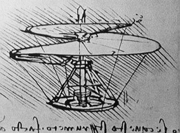E-Archive
Off the Beaten Track
in Vol. 11 - July Issue - Year 2010
Vertical Lift

Aerial screw of Leonardo da Vinci

Helicopter of Paul Cornu
The Master said, “Some have made flying carts with wood from the inner part of the jujube tree, using ox-leather straps fastened to turning blades so as to set the machine in motion.”
This quotation is taken from a book written in China in the fourth century A.D. and many believe it to be the first known description of a machine similar to a helicopter. Whether this contraption actually flew is highly doubtful, but nevertheless it shows that somebody had already grasped the basic principles of vertical flight as early as sixteen centuries ago: blades which were suitably inclined and which were made to spin fast enough to provide sufficient lift; easy to say, but impossible to execute with the technology available in those years and for many years to follow.
Surviving notes from Leonard Da Vinci’s personal library indicate that he had designed a type of helicopter and that he had actually built a working model, but no word on the type of propulsion used and on whether he managed to solve the problem of spinning of the craft caused by the rotation of the rotor, which was actually more like a helix. “I have discovered that a screw-shaped device such as this, if it is well made from starched linen, will rise in the air if turned quickly”, he wrote in the year 1480.
Numerous other inventors developed working models over the following years, but most of them were necessarily small sized in order to reduce weight and were powered by rubber bands. There were two main problems which hindered the development of a vertical lift flying machine: a sufficient level of power and a true understanding of the nature of lift and torque. With the advance of more sophisticated metallurgical production methods, steel springs were created which could power bigger and heavier models and keep them in the air for longer periods of time.
In 1861 the word “helicopter” was coined by a French inventor called Gustave de Ponton d’Amécourt, who also flew a small steam-powered model. He took the ancient Greek words “helix”, meaning spiral, and “pteron”, meaning wing.
The subsequent development of more powerful and lighter steam engines allowed the construction of what is considered the first full size working helicopter, built by Enrico Forlanini and demonstrated in a park in Milan in 1877. It wasn’t until the beginning of the following century, however, that the first manned flight in a helicopter took place. In November 1907 the French inventor Paul Cornu kept a height of 0.30 meters for about 20 seconds with a machine mounting two six-meter counter-rotating rotors driven by a 24-hp engine.
The first decades of the new century saw considerable improvements in flight control devices. An Argentine by the name of Raúl Pateras Pescara was the first to apply cyclic pitch, whereby lift could be cyclically increased and decreased by warping coaxial, contra-rotating and biplane rotors. This allowed lift to be equal on each side of the central shaft and eliminated the problem of dissymmetry of lift, which caused early helicopters to flip over. Pescara also invented a way to tilt the rotor hub forward by a few degrees, allowing the aircraft to move forward without a separate propeller. Because of the unreliability of engines available in those pioneering years, engine failure in flight was one of the greatest fears of pilots. To address this fear, Pescara demonstrated the principle of autorotation, by which the rotors were forced to spin by the current of air rushing upwards around a falling helicopter, slowing its fall to the point of allowing the helicopter to land safely.
During the 1920s and 1930s, numerous inventors came up with various methods to improve control and to eliminate the spinning of the craft caused by the rotors. In 1930 the Italian engineer Corradino D’Ascanio built a coaxial helicopter with two, two-bladed, counter-rotating rotors. He improved control considerably by applying auxiliary wings or servo-tabs on the trailing edges of the blades.
Although range and performance were still relatively poor compared to airplanes, it could be said that by 1936, with the development of the German Focke-Wulf Fw 61, helicopters had come of age. They were finding their place in more and more civilian and military fields of application.
By Giovanni Gregorat, Contributing Editor MFN & Sales Manager, Pometon Abrasives
Author: Giovanni Gregorat


























